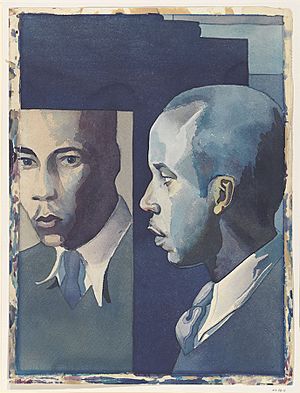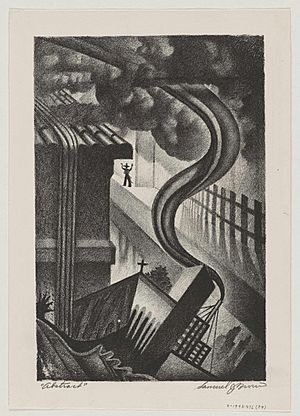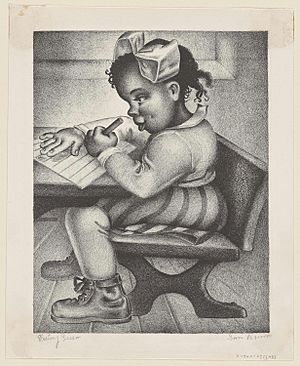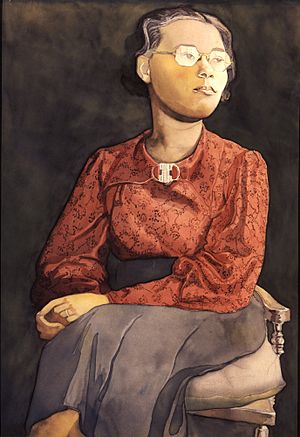Samuel Joseph Brown Jr. facts for kids
Quick facts for kids
Samuel Joseph Brown, Jr.
|
|
|---|---|

Self-Portrait by Samuel Joseph Brown Jr.
|
|
| Born | 1907 |
| Died | 1994 |
| Resting place | Eden Cemetery, Collingdale, PA |
| Education | Pennsylvania Museum and School of Industrial Art University of Pennsylvania |
Samuel Joseph Brown Jr. (1907–1994) was a talented American artist and teacher. He was known for his watercolors and prints. Brown was the first African American artist hired for a special government program called the Public Works of Art Project. This program helped artists during a tough time in history.
Brown often painted scenes from the lives of African Americans. He mainly used watercolor and oil paints. His art included portraits of people, beautiful landscapes, and various prints. You can find his paintings in famous places like the Philadelphia Museum of Art and the National Gallery of Art.
Contents
Growing Up and Learning Art
Samuel Joseph Brown Jr. was born in Wilmington, North Carolina. When he was about 10 years old, his family moved to Philadelphia in 1917. His father made mattresses, and his mother was a seamstress.
Brown showed artistic talent from a young age. In fourth grade, he won his first art award. He went to South Philadelphia High School. After school, he worked for a local printer, learning about silkscreen printing.
After high school in 1926, Brown studied art education for four years. He attended the Pennsylvania Museum and School of Industrial Art. This school is now known as the University of the Arts. Later, he earned a special degree in Fine Arts from the University of Pennsylvania.
His Journey as an Artist
Early Artistic Steps
Brown became good friends with another artist named Dox Thrash. They shared a studio for many years. In the mid-1930s, they even ran a sign-painting business together. Brown often worked different jobs to support his family while pursuing his art.
In 1933, he designed the cover for The Crisis magazine. This magazine was published by the NAACP, a group that works for civil rights. His drawing was called The Problem.
Working for the Government
In 1933, Samuel Joseph Brown Jr. was chosen for the Public Works of Art Project (PWAP). This was the first time the government hired artists to create art. Brown was the first African American artist to join this program. He mostly created watercolor paintings for it.
Later, in 1935, another government art program started. It was called the Work Progress Administration's Federal Art Project (FAP). Brown worked for the FAP in Philadelphia. He painted and also made prints in their workshop. He stayed with the FAP until 1938. After that, he became a full-time art teacher.
While working for the FAP, Brown spent most of his time painting. But he also learned printmaking. Some of his famous prints from this time include The Writing Lesson and Abstract.
A Productive Decade: The 1930s
The 1930s were a very busy time for Brown. He created many paintings while working for the FAP. His art received high praise in major art shows. He became well-known for his FAP paintings. People recognized him as one of the program's best artists.
In 1933, Brown showed two pieces in a competition by the Harmon Foundation. A year later, he displayed four works in an exhibit in Philadelphia. These included The Lynching and Smoking My Pipe.
His painting The Lynching was very powerful. It showed a difficult subject in a unique way. An article in the Philadelphia Tribune called it "one of the unusual paintings." It noted that Brown was an "individual painter" who broke away from traditional styles.
The Lynching was also part of an exhibit in New York in 1935. This show, called An Art Commentary on Lynching, was sponsored by the NAACP. Brown used a style that was almost like a cartoon. This helped him show a serious topic in a folk-like way.
The Philadelphia Museum of Art chose several of Brown's paintings for a long-term loan. These included The Lynching and his self-portrait, Smoking My Pipe. He was the only FAP artist from whom the museum selected more than one painting.
In 1934, Brown was one of over 500 artists chosen for a national exhibit. This show was at the Corcoran Gallery of Art in Washington, D.C. His painting was called So Tired. It was a watercolor of an African American scrubwoman. Some people found the painting shocking. But others, including First Lady Eleanor Roosevelt, praised it.
Eleanor Roosevelt even mentioned So Tired in her newspaper column years later. She called it The Scrub Woman. The original painting disappeared, so Brown recreated it in 1982. He titled the new version Scrubwoman II.
In 1936, Brown was one of four African American artists in a special exhibit. It was called New Horizons in American Art at the Museum of Modern Art. His painting Mrs. Simmons was very popular. He also had two other works in the show.
Brown's art was shown in Paris in 1938. He was one of only two Black artists whose works were chosen for the Three Centuries of American Art exhibition. Mrs. Simmons was featured there. He also showed two watercolors in Dallas, Texas, that same year. In 1939, he was part of a group show at the Baltimore Museum of Art.
From the 1940s to the 1970s
In 1945, Brown visited Mexico. He later showed many of the paintings from this trip in a solo exhibit in Philadelphia. He also had a solo show in Washington, D.C., in 1946.
While teaching in 1946, Brown created a series of posters. These posters were about global peace and brotherhood. First Lady Eleanor Roosevelt bought a set. She donated them to a school in New York. Brown called the series One World. He said it was about showing children of all races getting along.
In the 1950s and 1960s, Brown continued to win awards for his art. He also exhibited his work in local galleries. In 1969, he was called "the patriarch of living Philadelphia Negro painters." This means he was seen as a very important and respected older Black painter in Philadelphia.
Later Life and Art
Brown retired from teaching in 1971. But he never stopped creating art. He continued to paint. He also started making sculptures and jewelry. He painted portraits of school leaders, important Philadelphians, and his family and friends.
In 1986, a scholarship was created in his name at the University of the Arts. This honored his contributions to art and education.
His works continued to be shown in museums. In 1980, his art was part of a group show at the African American Museum in Philadelphia. In 1989, a traveling show organized by the Smithsonian included his self-portrait from 1985.
In 2015, Brown's watercolor The Odd Sister was part of an exhibit. This show, called “We Speak: Black Artists in Philadelphia, 1920s-1970s,” was at the Woodmere Art Museum. His painting had also been shown at a big international festival in 1975.
In 2021, his painting Urlene, Age Nine was featured in an exhibition. This was at the Delaware Art Museum.
Groups He Joined
Brown was a member of the Tra Club. This was a group of Black artists that started in 1921. He was the president of the club in 1932. He often showed his art at their yearly exhibitions.
He was also an early member of the Pyramid Club. This group was for Black male professionals. It was founded in 1937. Brown participated in the club's annual art shows.
Art Shows and Exhibitions
Group Exhibitions
- Philadelphia Museum of Art: 1934, 1973
- Public Works of Art Project artist exhibition, Corcoran Gallery of Art: 1934
- An Art Commentary on Lynching, Arthur U. Newton Galleries: 1935
- Harmon Foundation
- Howard University: 1935 and 1940
- University of Pennsylvania: 1936, 1975
- Federal Art Project exhibition, New Horizons in American Art exhibit, Museum of Modern Art and the FAP: 1936
- Pennsylvania Museum and School of Industrial Art: 1930, 1934 and 1937
- Museum of Modern Art: 1937
- MOMA's Three Centuries of American Art, Paris: 1938
- Texas Centennial Exposition: 1938
- Contemporary Negro Art at the Baltimore Museum of Art: 1939
- National Forum of Professional Artists, Philadelphia’s Municipal Services Building: 1969
- Philadelphia College of Art: 1973
- African American Museum of Philadelphia: 1980
- Brandywine Workshop: 1989
- Pennsylvania Academy of the Fine Arts, 2014
- Against the Odds: African American Artists and the Harmon Foundation at the Newark Art Museum: 1990
- Woodmere Art Museum: 2015
- Afro-American Images 1971: The Vision of Percy Ricks, Delaware Art Museum
Solo Exhibitions
- Philadelphia Art Alliance: 1945
- Barnett-Aden Gallery: 1946
- Balch Institute for Ethnic Studies in Philadelphia: 1983
Where His Art Is Kept
Samuel Joseph Brown Jr.'s artworks are held in many important collections. These include the White House, the National Gallery of Art, and the Smithsonian American Art Museum. You can also find his art at the Philadelphia Museum of Art, the Museum of Modern Art, and the Metropolitan Museum of Art.
His Teaching Career
Brown started as a substitute art teacher in Camden, New Jersey, in the early 1930s. In 1938, he became a full-time art teacher in Philadelphia. He taught commercial art at Bok Vocational High School. He also taught at Vaux Junior High School. Later, he spent 25 years teaching at Dobbins Vocational-Technical High School. Brown retired in 1971, after teaching for 33 years.
His Family Life
Samuel Joseph Brown Jr. married Miriam Lois Ellison in 1938. They met at a church event. Miriam was an elementary school teacher for 30 years. She was born in Palatka, Florida. Her family moved to Philadelphia when she was seven.
Samuel and Miriam had three children. Their daughter, Urlene, sadly passed away from leukemia when she was 25. She was the subject of his 1956 painting, Urlene, Age Nine.
Images for kids








